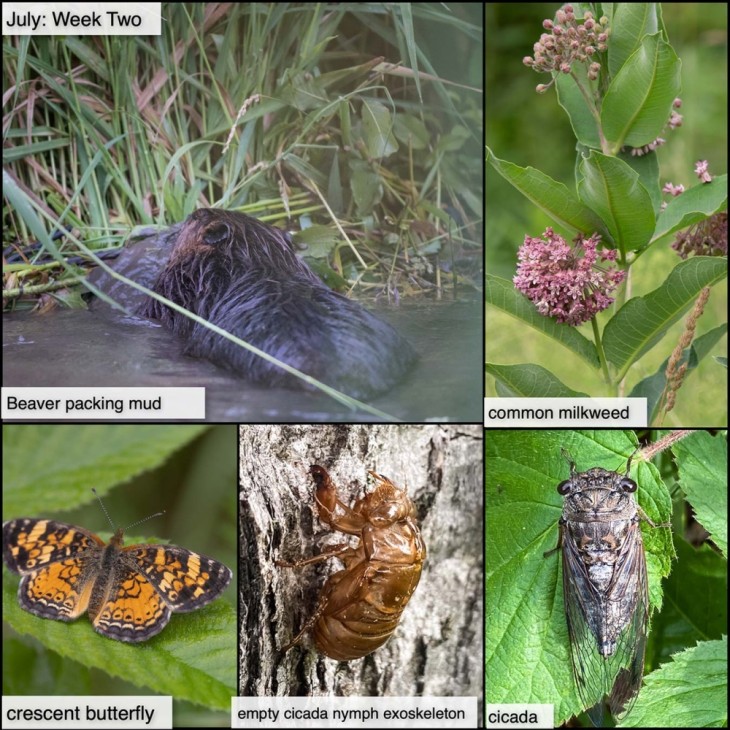This week in the woods, the recent combination of rain and heat has produced a bumper crop of mushrooms and other fungal forms, including crown-tipped coral. This common, easy-to-identify fungus grows directly on dead wood, and we’ve found it several times on rotting maple logs. Here’s more information about the species and other coral fungi from expert Tom Volk.
If you encounter a big, beautiful spotted butterfly in the forest in July, chances are high that it’s a northern pearly-eye. This butterfly thrives in shade and is often active at dawn and dusk. According to the Butterflies and Moths of North America project (BAMONA), its adult foods are “dung, fungi, carrion, and sap from willows, poplars, and birch.” Common larval hosts are woodland grasses. You can learn more about the species at the BAMONA site.
We’re seeing more dragonflies and damselflies now, including bluets on the edges of forest wetlands. There are many similar looking blue species in the Enallagma genus, as well as bluets which aren’t blue at all; see, for example, this gallery from the Vermont Center for Ecostudies. So, what’s the difference between damselflies and dragonflies? The Center for Biological Diversity offers this short video tutorial, complete with funky soundtrack. Two of the easy-to-see differences: damselflies have separated eyes as opposed to dragonflies’ larger, close-together ones, and when they’re at rest, damselflies typically hold their wings pressed together, over their backs.
Many of our songbirds may raise more than one batch of chicks each summer, depending on food, weather and other factors. This is often the case with house wrens, and their first edition fledglings are now out of the nest, but still perching together and shrieking at their parents. House wrens are common yard birds as well as forest dwellers, and as Carolyn Lorié notes in this Outside Story essay, they’re “tiny terrors.” They’ll face down predators in defense of their nest, and occasionally even dive bomb humans. They’re also notorious for ousting bluebirds and other species from bird boxes and other desirable nesting cavities. Here’s a Cornell Lab of Ornithology profile of the birds, including recordings of their calls. Another interesting detail about wrens: they’ll often include snakeskin in their nesting materials. This research paper suggests that birds do this to deter mammalian predators.
As common milkweed starts to bloom, a host of insects also appear. We have yet to see any monarch butterflies, but there are already many other butterflies, moths, bees, wasps, ants, and beetles showing up in the milkweed patch. Here’s an Outside Story essay by Barb Mackay describing the plant’s value to other species, and the way that different creatures use, or avoid, its toxic cardiac glycosides. And here’s a link from the USDA, describing how milkweed flowers have slits that serve as temporary leg hold traps for bees and other insects, a trick that aids pollination.
One of first to arrive on milkweed plants (because they never left) are red milkweed beetles. The adults, which are mating now, are easy to identify: they have red bodies with black spots, and extra-long antenna. The University of Wisconsin’s “Bug Lady” has this post about them, which explains how the insects rely on milkweed in both their larval stage (when they feed on roots) and adult phase (when they nosh on leaves, buds, and flowers). In common with monarch caterpillars and some other milkweed feeders, red milkweed beetles make strategically placed bites to drain the plant’s defensive latex in the area they’re feeding. This prevents the latex from gumming up their mouthparts.
Red elderberry berries are ripe now. We previously noted the plant’s odd-looking purple blooms back in our Fourth Week of April post, and noted its wildlife value. The berries can be toxic in raw form, so best just to enjoy their good looks, and leave the eating to birds and other creatures.
Orange mycena are blaze orange mushrooms that typically emerge in clusters out of dead wood. Although they superficially resemble Jack-o’-lantern mushrooms, their stalks are skinnier, and their gills also have a different appearance. Mycena also have a concentrated darker spot of color on the knobs (bumps) at the top of their caps. You can read more about them here, once again from Tom Volk.
As noted on this Vermont Fish and Wildlife species page, eastern chipmunks have two litters a summer. They’ve just finished raising the first batch of young and will breed again this month. Which is why we encountered this naïve young animal, who was happy to pose for a close-up portrait.
In this difficult period, many of us find joy in observing local nature, and many families are seeking outdoor enrichment opportunities for children. Here are nine photographs taken this past week, most within 15 miles of the Northern Woodlands office in Lyme, New Hampshire. We hope you enjoy using this grid as a prompt for your own explorations, or as the basis for a game of family forest tic-tac-toe.
What are you seeing in the woods this week? Share your images with us on Facebook, or submit a special photo for possible inclusion in our monthly online Reader Photo Gallery.


